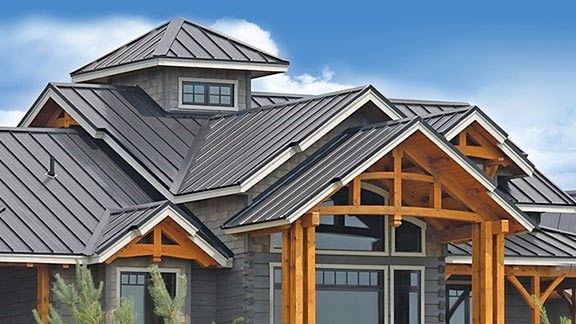The time to repair the roof is when the sun is shining. ~ John F. Kennedy

Your roof is one of the most important parts of your house and conceivably one of the most expensive. Problems are often found when the rain is pouring and those problems can end up causing damage to a variety of other parts of your home. So with sunny skies ahead, now is the time for a little roof talk.
While most people are familiar with shingle roofs when it comes to home roofing options, there are actually a few different roof types available. One that is gaining a significant amount of popularity in recent years is metal roofing, due in part to its extreme durability and resistance to environmental factors that can damage traditional shingles.
Once upon a time, metal roofing was largely made up of flat panels which seemed more at home on businesses or other non-residential structures. The material has come a long way since then, however. Modern metal roofing often mimics the look of shingles or tile roofs, adding a unique beauty to your home while also conveying a number of advantages over other materials.
Advantages of Metal Roofs
There are several benefits to choosing a metal roof. While the full list of advantages will differ depending on the type of metal roof you choose and where you live, here are some of the most common ones:
- Longevity: Traditional asphalt shingles have a life expectancy of around 10 to 15 years on average, though some may last up to 20 years or more under ideal conditions. Metal roofs, on the other hand, have a life expectancy closer to 70 years.
- Customizability: When choosing shingles, you’re limited by the color options and layouts that are available at the time of purchase. Metal roofs are often paintable to give you a wider range of options.
- Fire Resistance: Unlike shingles, metal roofs will not ignite in the event of fire or lightning strikes. And contrary to myths, they do not attract lighting to your home.
- Energy Efficiency: Because metal roofs reflect UV rays, they tend to stay cooler than other roofing materials during the heat of summer. This can result in less radiant heat buildup, which in turn will reduce your home cooling costs.
Metal roofs also typically contain a significant amount of post-consumer recycled material and can themselves be recycled instead of scrapped once they are replaced. This is a great benefit for those who want to have more control over their environmental impact.
Installing a Metal Roof
When it comes to installing a metal roof, things are a bit more complicated than they are for traditional shingle roofs. The additional work required is worth it, though, as it helps to ensure a leak-free roof that will last for decades.
Most of the time, the existing roof is stripped off completely and the underlying sheathing and flashing are inspected and replaced as needed. Additional plywood or similar materials may also be installed if necessary to provide a firm backing for the metal roof. A waterproofing underlayment is also added to the entire roof deck, along with slip sheets that go between the underlayment and the metal itself so that the metal will be able to move slightly as it expands and contracts.
The roof itself is installed in panels, with polyurethane sealants used to adhere to the metal and allow for movement and expansion as the weather changes. The edges of panels are crimped together to ensure a leak-free fit, providing seams that blend in naturally with the pattern of the roof. Chimneys and other edges are sealed around, and the eaves are capped to prevent water from getting behind the panels at the edges.
Leave a Reply
You must be logged in to post a comment.